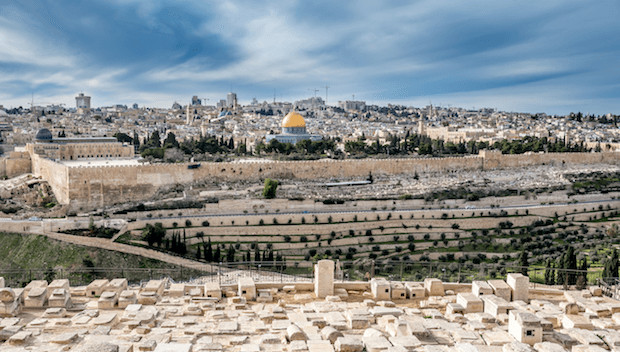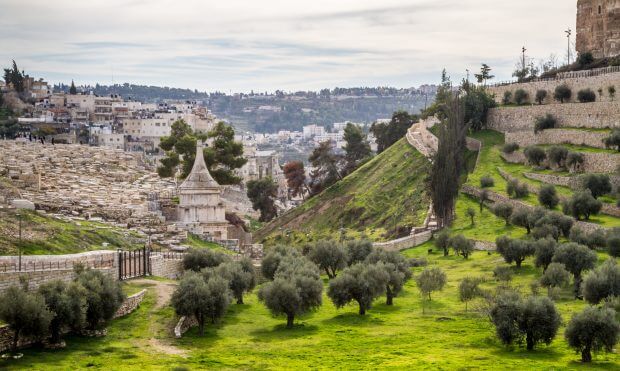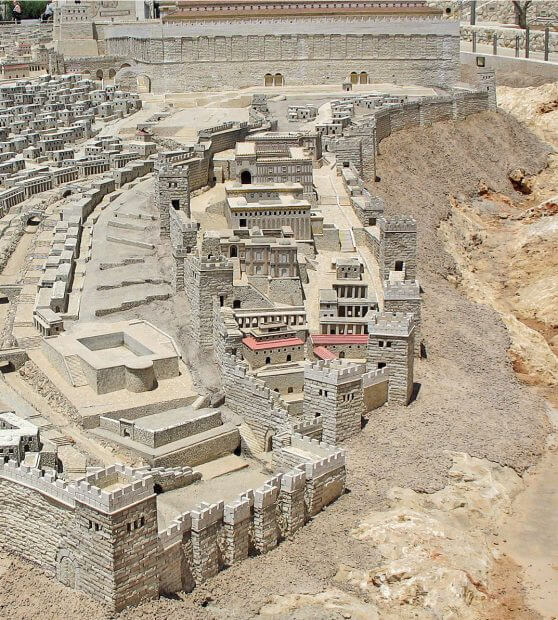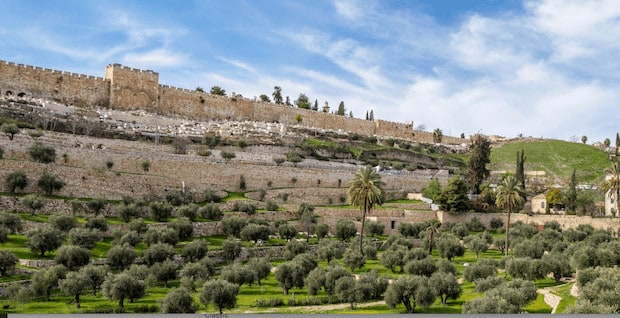Thirty-three miles east of the Mediterranean Sea on a limestone plateau in the Judaean Hills rests one of the oldest cities in the world: Jerusalem.
Jerusalem is mentioned 660 times in the Old Testament and 141 in the New—more if you count all its synonyms like Zion, city of God, and Salem.1
No city has been written and sung about as much as Jerusalem.2
Or fought over.
It’s been conquered more than 40 times including by the Persians, the Romans, the Ottoman Turks, and the British Empire, and more than 100 battles have been fought for control of Jerusalem.3
Even its name, which means “foundation of peace,” elicits an emotional response (though historically it’s been anything but a “city of peace”).4
Out of all the cities in ancient Israel, why did David chose to set up his kingdom here? Biblical scholars and historians offer some interesting reasons.
1. Jerusalem had a natural defense system.
Jerusalem’s most advantageous feature was its topography. Three prominent hills surrounded the city:
- Mount Moriah (on the Eastern hill) known today as the Temple Mount, where both the First and Second Temple stood (1 Kings 6; Ezra 5)
- The Mount of Olives, a two-mile-long ridge to the east with three summits that stood 300 feet higher than Mount Moriah and over 100 feet higher than any other part of the city
- Mount Zion, ancient Jerusalem’s Western Hill and the highest point in the city (Ps 48; 125)

These mountains connected to several deep, rocky valleys:
- The Kidron valley ran parallel to the Mount of Olives and continued all the way to the Dead Sea, hedging in Jerusalem on the east5
- The Central or “Tyropoeon Valley” cut through the middle of the city and separated Mount Moriah from Mount Zion
- The Hinnom Valley (Gehenna), the lowest point in the city, curved around Jerusalem’s west and south sides6

Together these hills and valleys formed a natural defense system:
Though in the Bible one is said to travel “up to Jerusalem,” it is far from the highest point in the immediate vicinity. Nestled among the “hills of Jerusalem” (Ps 125:2), the city is hidden from the eyes of an approaching traveler until he mounts one of the higher ridges.7
Not only was it hidden, but approaching Jerusalem was so challenging that foreign invaders traveling through the land often circumvented the city altogether.
The original Jebusite city David captured 3,000 years ago, “the fortress of Zion” that he later named “the City of David” (2 Sam. 5:7; 2 Sam. 5:9; 1 Chron 11:5), rested hundreds of feet lower than these hills.

This made Jerusalem a safe place from which David could rule—so strong and fortified he compared it to God’s protection of his people:
As the mountains surround Jerusalem, so the Lord surrounds His people both now and forevermore. (Ps 125:2; see also Ps 121:1–2)
2. Jerusalem had a continual supply of fresh water.
Though Jerusalem sits on the spine of a stretch of land that gets no rain for half the year, at the base of the Kidron Valley bubbled the largest freshwater spring in the Jerusalem mountains: the Gihon Springs (גִיַח or giyach in Hebrew, “to burst forth”).
Water from the Gihon flowed through a natural tunnel to the base of a shaft. It operated like a well that provided a substantial and continual supply of water for its residents to live on and for the constant temple rituals that involved purity regulations (i.e., lots of washing).
With a dependable freshwater source, David’s kingdom could grow and its people could worship God appropriately.
3. Jerusalem was politically neutral and centrally located.
Jerusalem didn’t belong to any of the twelve Jewish tribes. This enabled David to conquer the city (2 Sam 5:1–12) and use the neutral property as a symbol for a united Israel.
It was also perfectly established at a crossroads in the middle of the land, making it accessible to all Jews (and gentiles) traveling north to south, east to west. And this was not by chance.
Through Ezekiel God said:
This is Jerusalem. I have set her in the center of the nations, with countries all around her. (5:5, emphasis added)
If God purposefully “set Jerusalem in the center of the nations,” did he also influence David’s decision set up his kingdom there?
A more divine reason for choosing Jerusalem
Though it was the wise and practical place from which to rule, ultimately David did not choose Jerusalem.
God did.
And he had different reasons than David for doing so:
Since the day when I brought my people out of the land of Egypt, I did not choose any city in all the tribes of Israel in which to build a house for my name to be there. Neither did I choose any man as prince over my people Israel; but now I have chosen Jerusalem for my name to be there and I have chosen David to be over my people Israel. (2 Chron 6:5–6, emphasis added)
No wonder God established Jerusalem in the “center of the nations.” Jerusalem is where God would dwell (Ps 9:11; 76:2; 132:13–14; Zech 8:3) and where he would “put [his] name forever” (2 Chron 33:7; Deut 12:10–11; see also Exod 34:5–7).
From this city nestled high in the Judean mountains, God would make his name known to the entire world.
There’s no doubt David knew it was by God’s appointment he was to establish his kingdom there.
But he also knew Jerusalem was ultimately not his kingdom at all:
Great is the LORD and greatly to be praised in the city of our God, in His holy mountain. Beautiful in elevation, the joy of the whole earth, is Mount Zion on the sides of the north, the city of the great King” (Ps 48:1–2; see also Matt 5:34–35)
It’s God’s.
***
Understanding the geography of Israel enhances our understanding of the narrative of the Bible.
For more information on the geographical, cultural, and historical settings of Jerusalem, I recommend Archaeological and Theological Studies of Jerusalem (10 vols.) and the Holman Bible Atlas: A Complete Guide to the Expansive Geography of Biblical History.
To better understand the how the different books of the Old Testament fit together to tell the grand story of God’s plan of salvation, check out Mobile Ed Mobile Ed: OT300 Old Testament Theology (16 hour course)
Have you been to Jerusalem or studied this area of Israel? Comment in the post.
Karen Engle received her MA in Biblical Studies and Theology from Western Seminary. She is an editor for Faithlife and regularly takes groups to Israel.
- Beitzel, B.J., & Lyle, K.A. (Eds.). (2016). Lexham Geographic Commentary on the Gospels. Bellingham, WA: Lexham Press.
- Ibid.
- Seligson, Dan, et al., 2019, CJP, “50 Facts about Jerusalem,” https://www.cjp.org/blog/50-facts-about-jerusalem, accessed 09 April 2019
- Beitzel, B.J., & Lyle, K.A. (Eds.). (2016). Lexham Geographic Commentary on the Gospels. Bellingham, WA: Lexham Press.
- Elwell, Walter, Baker Encyclopedia of the Bible, “Jerusalem,” (Baker Publishing Group, Ada, MI), 1998.
- Freeman, David Noel, et al., The Anchor Yale Bible Dictionary, “Hinnom valley,” (Yale University Press), 1992.
- Elwell, Walter, Baker Encyclopedia of the Bible, “Jerusalem,” (Baker Publishing Group, Ada, MI), 1998.






